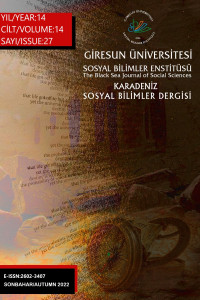Rehabilitasyon Psikolojik Danışmanlığı: Türkiye Uygulamalarının Temelleri: Engellilere Yönelik Damgalanmanın Açıklanması ve Ölçülmesi
Öz
Bu makale, engelli insanlara yönelik damgalama ile ilgili teorik bilgiler ve bunlarla ilgili terimler hakkında tanıtım bilgisi sunmayı amaçlamaktadır. Tutumlar, insanların tutum nesnesi hakkında ne düşündüklerini ve hissettiklerini etkileyen davranışsal, bilişsel ve duygusal bileşenlerden oluşur (Lee ve Rodda, 1994). Livneh, Chan ve Kaya (2012), engelli kişilerin olumsuz tutumlara maruz kaldığını belirtmiştir. Terim olarak damgalanma, olumsuz tutum ve algılarla eşitlenmiştir. Bu çalışma, literatür taraması yaparak, köken ve doğa, yapı (boyutlar ve bileşenler) itibariyle engellilere yönelik damgalanmayı etkileyen faktörler hakkında giriş niteliğinde bilgiler sağlamaktadır. Ayrıca engelli insanlara yönelik tutumların ölçülmesi ile ilgili olarak göze çarpmayan davranışsal ölçümler, projektif teknikler, gizleme kullanılan teknikler ve fizyolojik yöntemler açıklanmıştır. Son olarak engellilere insanlara yönelik damgalanmayla ilgili olarak potansiyel araştırma konuları tartışılmıştır. Türkiye’de engellilerle yönelik olarak yürütülmüş , rehabilitasyon psikolojik danışmanlığı ile ilgili teorik ve araştırma çalışmaları azdır. Bu konuda daha fazla çalışma yapılması gerekmektedir. Dolayısıyla, bu makalenin amacı, Türkiye’de rehabilitasyon psikolojik danışmanlık literatürüne engelli insanlara yönelik damgalama ile ilgili katkıda bulunmaktır.
Anahtar Kelimeler
Rehabilitasyon psikolojik danışmanlığı damgalanma olçum engelli insanlar
Kaynakça
- Altman, B. M. (2001). Disability definitions, models, classification schemes, and applications. In G. L. Albrecht, K. D. Seelman, & M. Bury (Eds.), Handbook of disability studies (pp. 97-122). Thousand Oaks, CA: Sage.
- Antonak, R., & Livneh, H. (1995). Direct and indirect methods to measure attitudes toward persons with disabilities, with an exegesis of the error-choice test method. Rehabilitation Psychology, 40(1), 3–24.
- Antonak, R F, & Livneh, H. (2000). Measurement of attitudes towards persons with disabilities. Disability And Rehabilitation, 22(5), 211–224.
- Bohner, G., & Dickel, N. (2011). Attitudes and attitude change. Annual Review Of Psychology, 62, 391–417. doi:10.1146/annurev.psych.121208.131609
- Chan, F., Livneh, H., Pruett, S., Wang, C. C., & Zheng, L. X. (2009). Societal attitudes toward disability: Concepts, measurements, and interventions. In F. Chan, E. D. Cardoso, & J. A. Chronister (Eds.), Understanding psychosocial adjustment to chronic illness and disability: A handbook for evidence-based practitioners in rehabilitation (pp. 333-367). New York: Springer.
- Dunlop, K. H., Stoneman, Z., & Cantrell, M. L. (1980). Social interaction of exceptional and 0ther children in a mainstreamed preschool classroom. Exceptional Children, 47(2), 132–141.
- Fichten, C. S. (1986). Self, other, and situation-referent automatic thoughts: Interaction between people who have a physical disability and those who do not. Cognitive Therapy and Research, 10, 571-587.
- Gargiulo, R. M., & Yonker, R. J. (1983). Assessing teachers’ attitude toward the handicapped: A methodological investigation. Psychology in the Schools, 20, 229–233.
- Greenwald, A. G., Poehlman, T. A., Uhlmann, E. L., & Banaji, M. R. (2009). Understanding and using the Implicit Association Test: III. Meta-analysis of predictive validity. Journal Of Personality And Social Psychology, 97(1), 17–41. doi:10.1037/a0015575
- Himmelfarb, B. (1993). The measurement of attitudes. In A. H. Eagley, & S. Chaiken, (Eds.), The psychology of Attitudes (pp.23-87). Orlando; FL: Harcourt Brace Jovanich
- Kleck, R., Ono, H., & Hastorf, A. H. (1966). The Effects of Physical Deviance upon Face-to-Face Interaction. Human Relations, 19(4), 425–436.
- Kurzban, R., & Leary, M. R. (2001). Evolutionary origins of stigmatization: The functions of social exclusion. Psychological Bulletin, 127 (2), 187-208.
- Lee, T. M. C., & Rodda, M. (1994). Modification of attitudes toward people with disabilities. Canadian Journal of Rehabilitation, 7(4), 229-238.
- Livneh, H., & Antonak, R. F. (1994). Indirect methods to measure attitudes toward persons with disabilities. Rehabilitation Education, 8(2), 103-137.
- Livneh, H., Chan, F., & Kaya, C. (2012). The stigma of physical and sensory disabilities. In P. Corrigan (Ed.), The stigma of disease and disability: Empirical models and implications for change. Washington, DC: American Psychological Press.
- Mackelprang, R. W., & Salsgiver, R. O. (1999). Disability: A diversity model approach in human service practice. Pacific Grove, CA: Brooks/Cole.
- McCauley, R. W., Bruininks, R. H., & Kennedy, P. (1976). Behavioral Interactions of Hearing Impaired Children in Regular Classrooms. Journal of Special Education, 10(3), 277.
- Pancer, S. M., Adams, D. A., Mollard, D., Solsberg, D., & Tammen, L. (1979). Perceived distinctiveness of the handicapped. The Journal Of Social Psychology, 108(Second Half), 275–276.
- Peyton, S., Chaddick, J., & Gorsuch, R. (1980). Willingness to treat alcoholics; a study of graduate social work students. Journal of Studies on Alcohol, 41(9), 935–940.
- Smart, Julie (2009). Disability, society and the individual (2nd ed.). Austin, Texas: Pro-ed,
- Smart, L., & Wegner, D. M. (2000). The hidden costs of hidden stigma. In T. F. Heatherton, R. E. Cleck, M. R. Hebl, & J. G. Hull (Eds.), The social psychology of stigma (pp. 220-242). New York: Guilford Press
- Vander Kolk, C. J. (1977). Physiological and self-reported reactions in various suggested interracial encounters. The Journal of social psychology, 102(2), 321-322.
- Wright, B. A. (1983). Physical disability - a psychosocial approach (2nd ed.). New York: HarperCollins Publishers.
Ayrıntılar
| Birincil Dil | Türkçe |
|---|---|
| Bölüm | Makaleler |
| Yazarlar | |
| Erken Görünüm Tarihi | 22 Ekim 2022 |
| Yayımlanma Tarihi | 31 Aralık 2022 |
| Gönderilme Tarihi | 31 Aralık 2021 |
| Yayımlandığı Sayı | Yıl 2022 Cilt: 14 Sayı: 27 |


